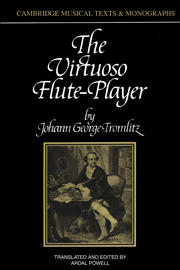Book contents
- Frontmatter
- Contents
- Translator's note
- Introduction by Eileen Hadidian
- Title in the series
- DETAILED AND THOROUGH TUTOR FOR PLAYING THE FLUTE
- Foreword
- Introduction
- 1 The flute and its character
- 2 Holding the flute, and the embouchure
- 3 Fingering
- 4 The notes and rests, their values and denominations, and the other musical signs
- 5 Time-signatures, and how the notes are divided and counted in them; the beat itself, or counting time according to an appointed tempo
- 6 Tone and pure intonation
- 7 Modern key-signatures
- 8 The articulation proper to this instrument, or the means of governing the wind suitably, as well in slow as in moderately quick movements; also called the single tongue
- 9 The technique for executing fast and very fast passages clearly and roundly; also, though improperly, called the ‘double tongue’
- 10 The ornaments
- 11 The trill
- 12 Fermatas and cadenzas
- 13 The taking of breath in flute-playing
- 14 The discretionary ornaments; or how to vary a simple melody according to the rules of harmony, and to use these variations in a good and suitable way appropriate to the material
- 15 Summary of the whole, together with a few remarks for pupils and masters
- Fingering-chart
- Select bibliography
- Index
14 - The discretionary ornaments; or how to vary a simple melody according to the rules of harmony, and to use these variations in a good and suitable way appropriate to the material
Published online by Cambridge University Press: 01 June 2011
- Frontmatter
- Contents
- Translator's note
- Introduction by Eileen Hadidian
- Title in the series
- DETAILED AND THOROUGH TUTOR FOR PLAYING THE FLUTE
- Foreword
- Introduction
- 1 The flute and its character
- 2 Holding the flute, and the embouchure
- 3 Fingering
- 4 The notes and rests, their values and denominations, and the other musical signs
- 5 Time-signatures, and how the notes are divided and counted in them; the beat itself, or counting time according to an appointed tempo
- 6 Tone and pure intonation
- 7 Modern key-signatures
- 8 The articulation proper to this instrument, or the means of governing the wind suitably, as well in slow as in moderately quick movements; also called the single tongue
- 9 The technique for executing fast and very fast passages clearly and roundly; also, though improperly, called the ‘double tongue’
- 10 The ornaments
- 11 The trill
- 12 Fermatas and cadenzas
- 13 The taking of breath in flute-playing
- 14 The discretionary ornaments; or how to vary a simple melody according to the rules of harmony, and to use these variations in a good and suitable way appropriate to the material
- 15 Summary of the whole, together with a few remarks for pupils and masters
- Fingering-chart
- Select bibliography
- Index
Summary
Since the discretionary ornaments too are an element of good and varied playing and make up a part of it, it is important to deal with them specifically as well. If they were to be left out, it would unfortunately be likely that the inclination and craving for variation that seems to be innate to everybody would, without proper direction, do more harm than good. To make the basics of these ornaments comprehensible and intelligible to someone who has no knowledge of harmony is certainly no easy matter; and it is impossible to teach them quite fully to such a person if this knowledge is lacking. To write down harmonised movements for a pupil who does not know harmony, and try to show the analysis of isolated passages, is nothing better than a useless exercise, which in this manner, either by himself or with the help of a teacher, he will certainly not grasp and understand in such a way that he can use it on other cases too. The teacher will give a dull discourse, and when he has finished the pupil will not have understood him. But if he really wants to have variations in his playing, then the teacher must demonstrate for him, if he but understands it (for many socalled teachers understand nothing about it, even in many cases great instrumentalists do not); and the pupil repeats it after him.
Information
- Type
- Chapter
- Information
- The Virtuoso Flute-Player , pp. 286 - 309Publisher: Cambridge University PressPrint publication year: 1991
